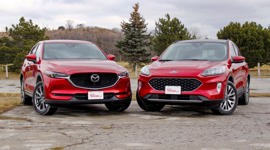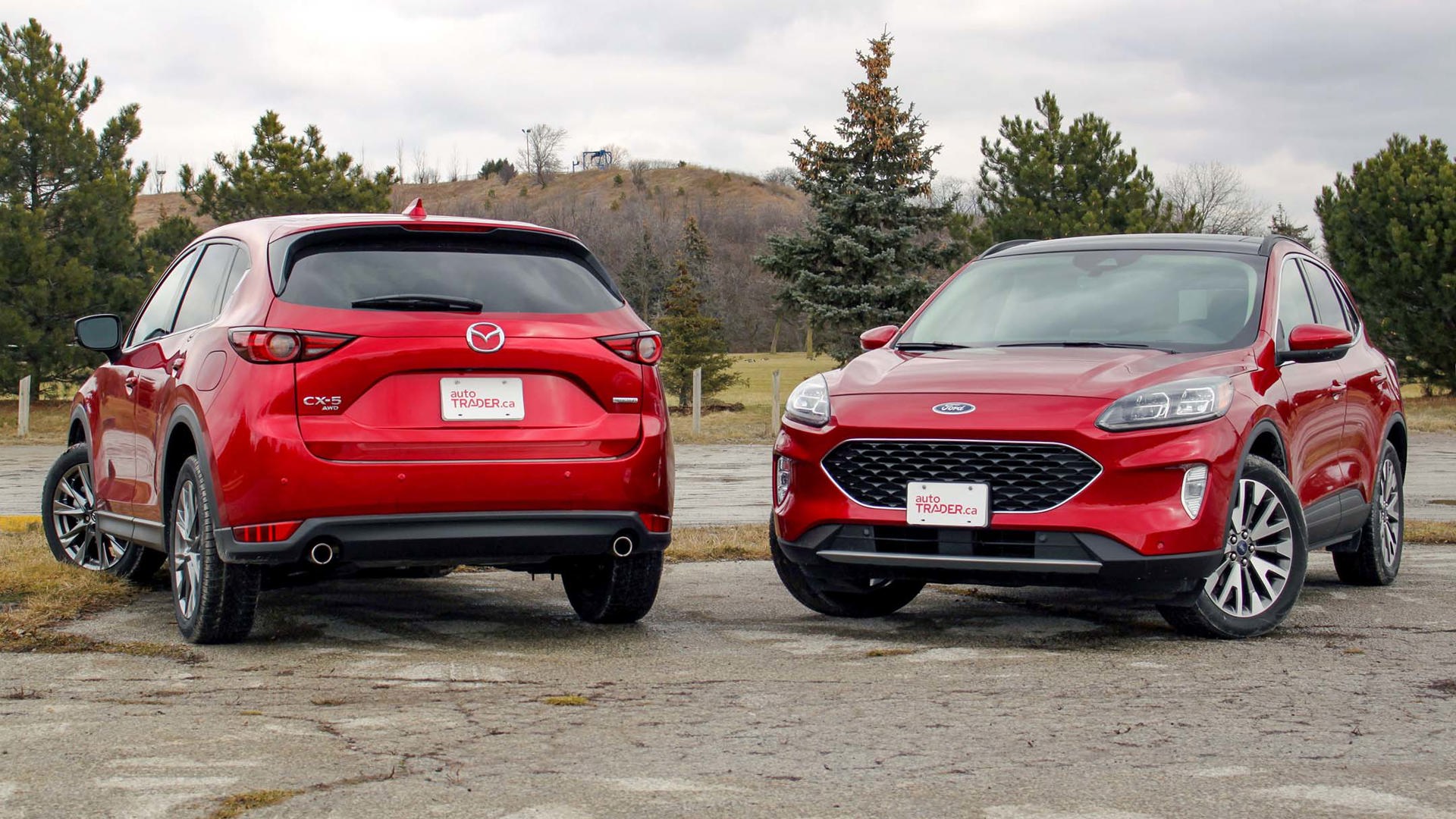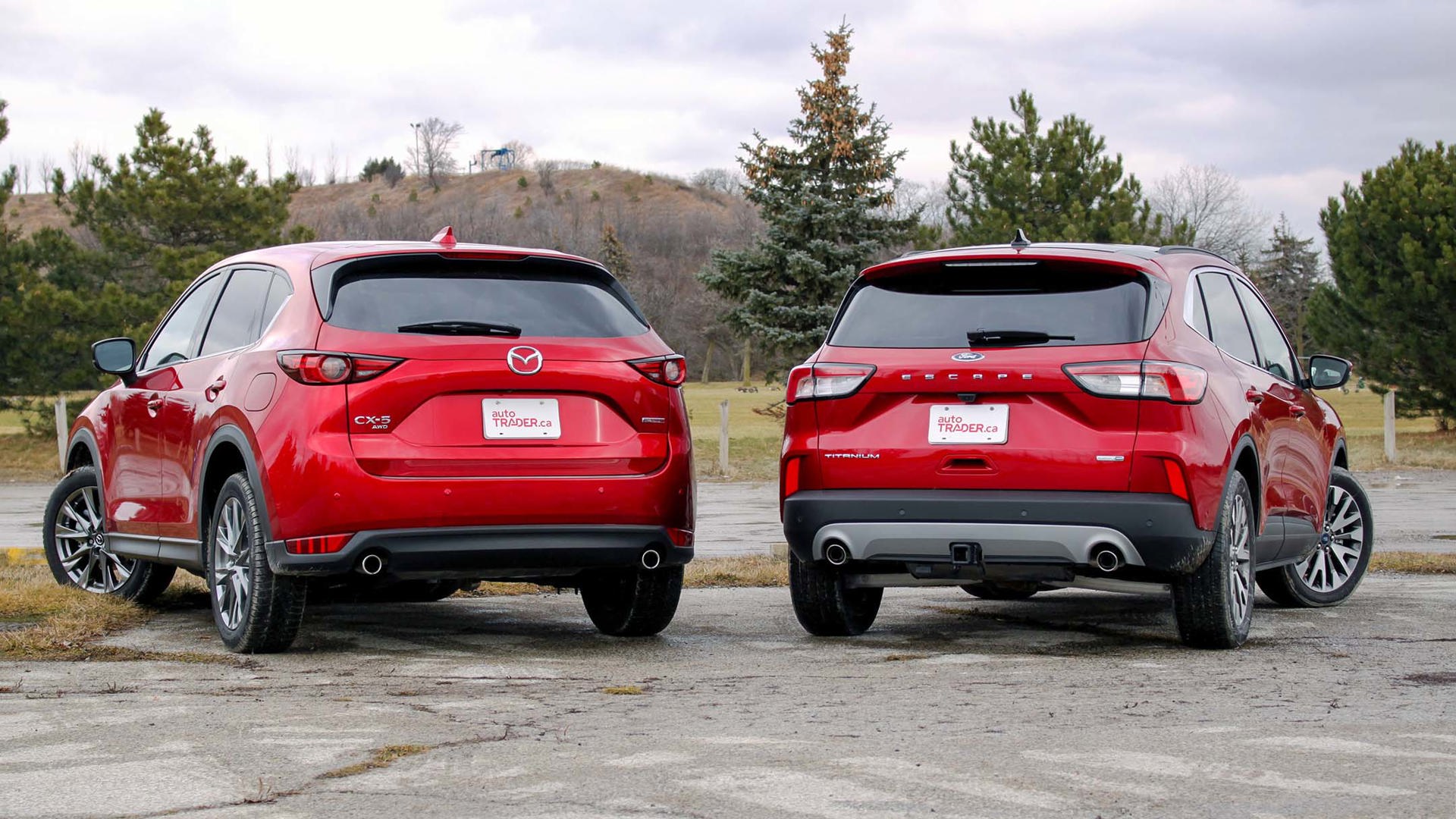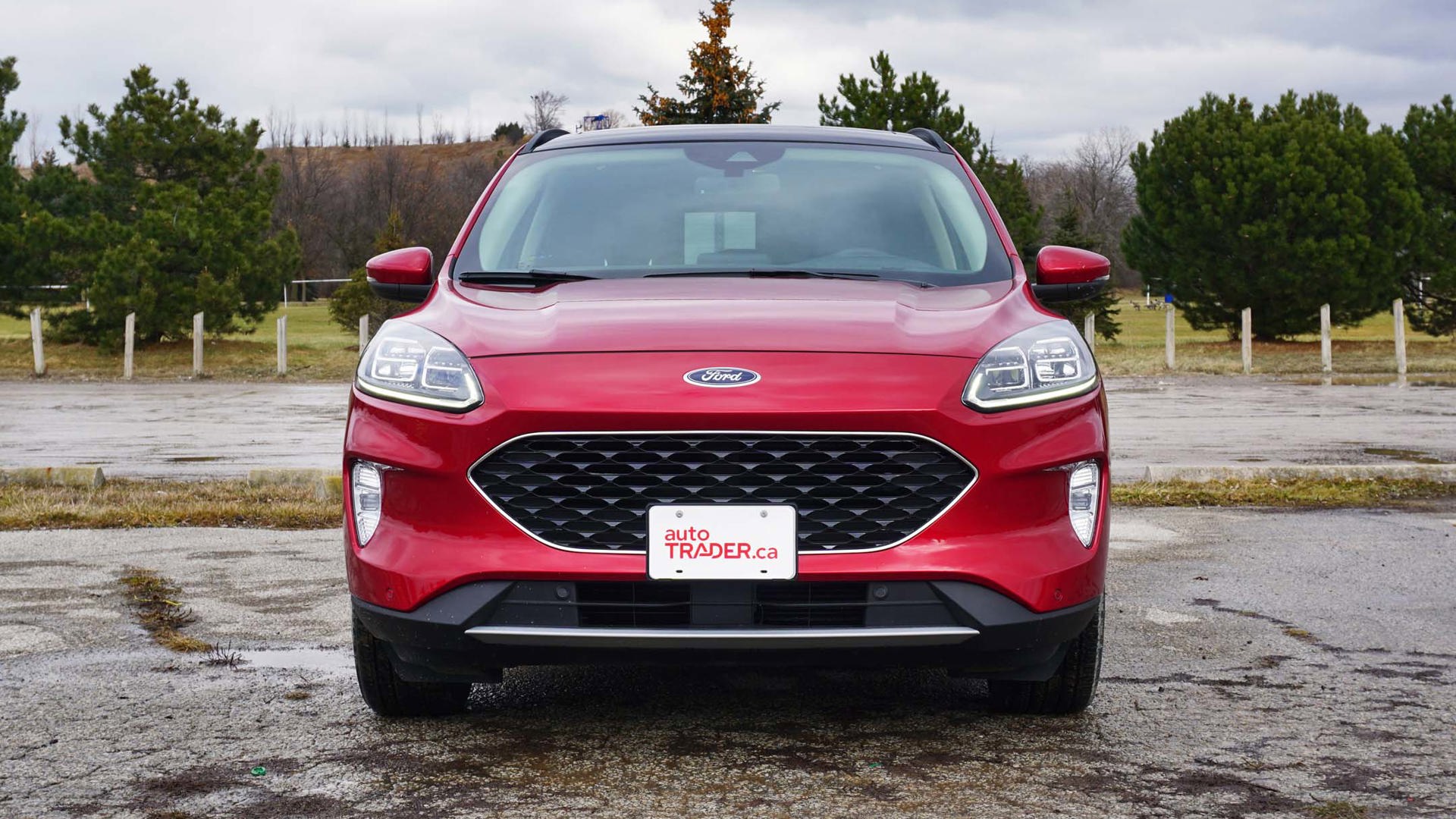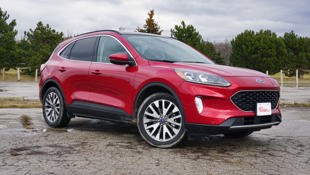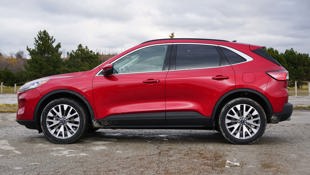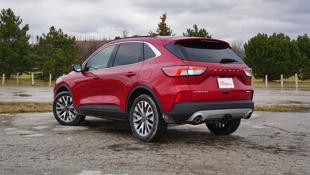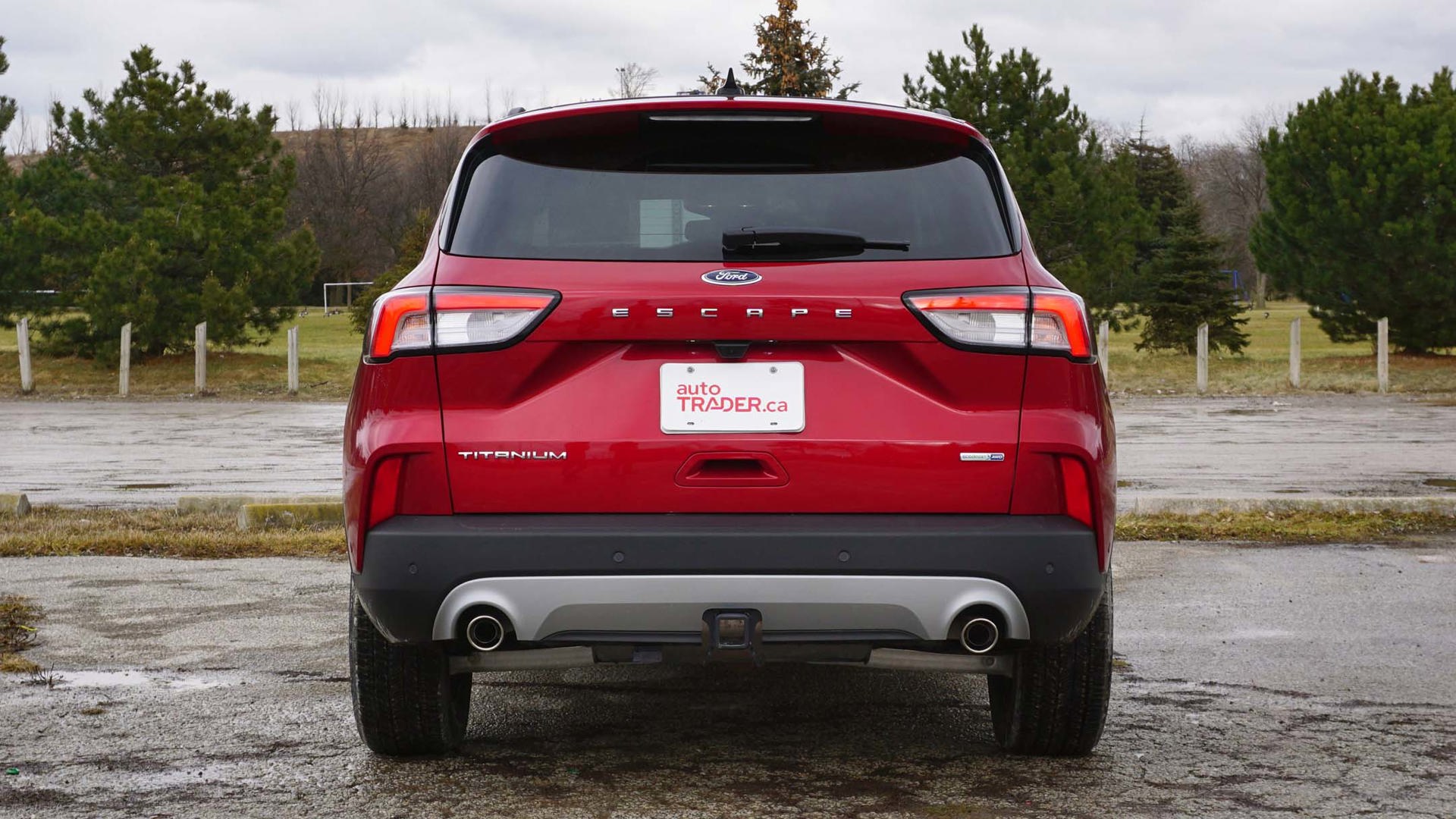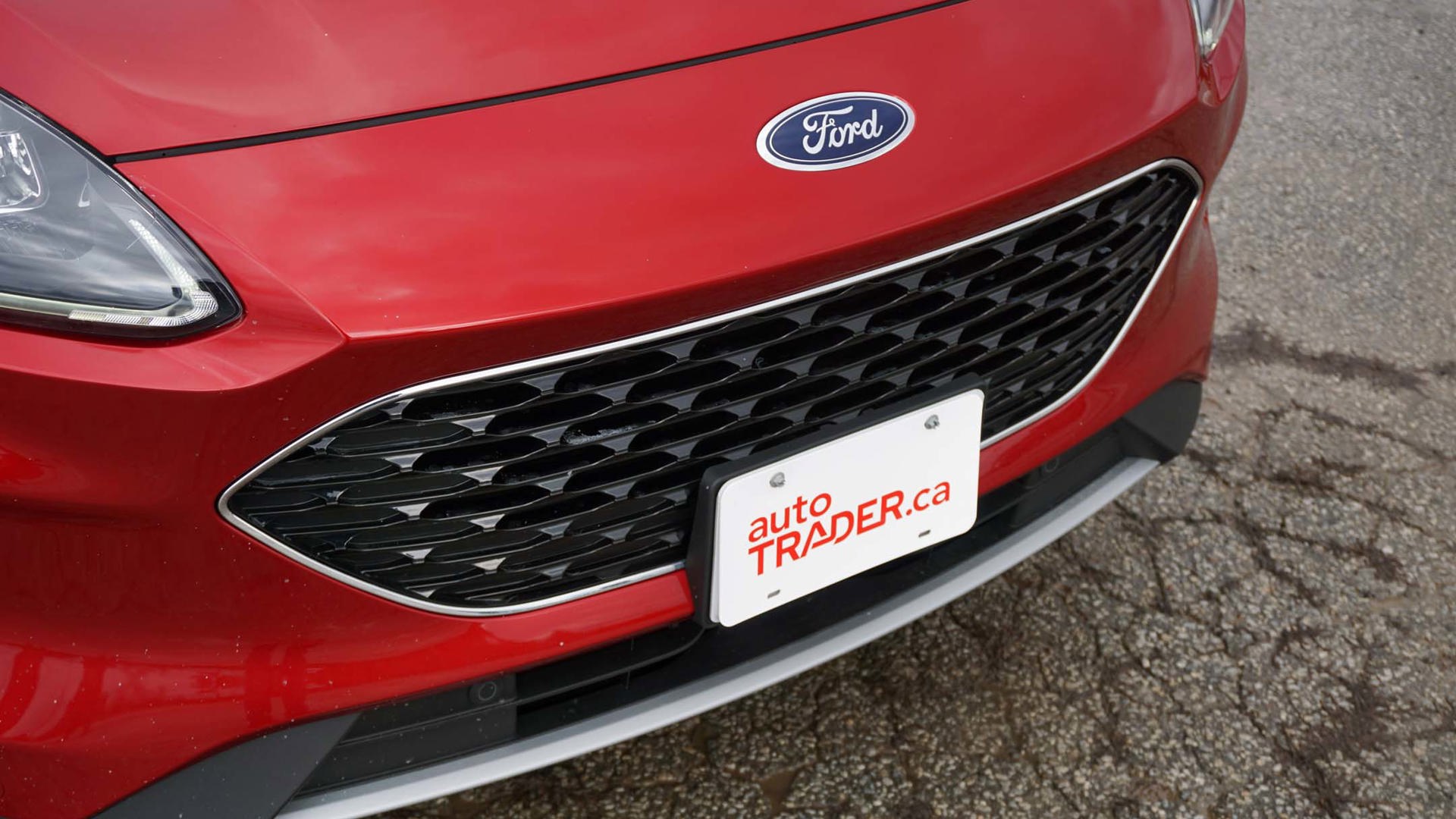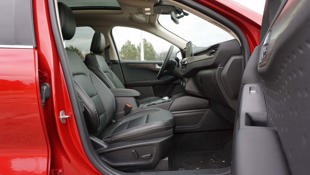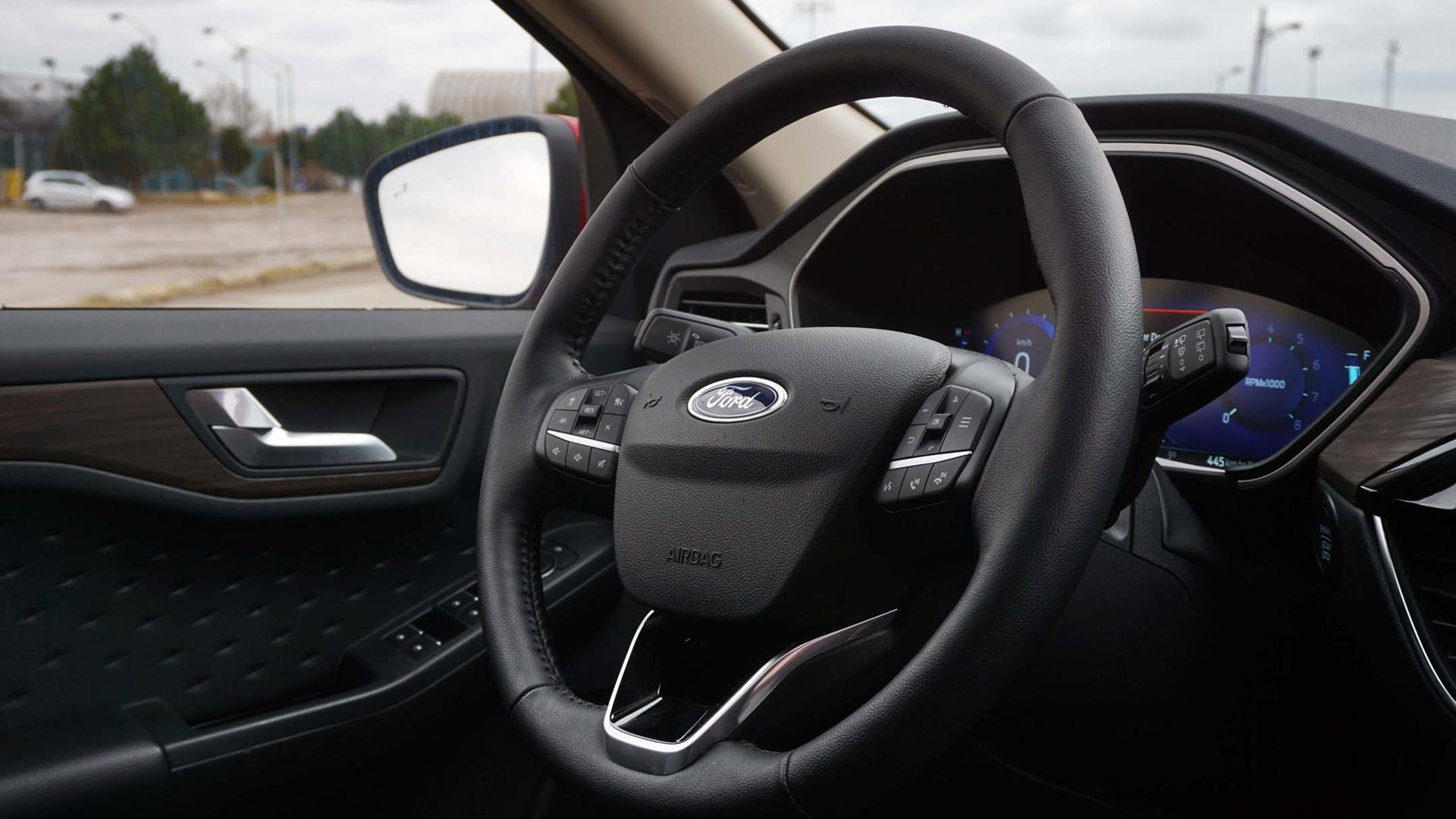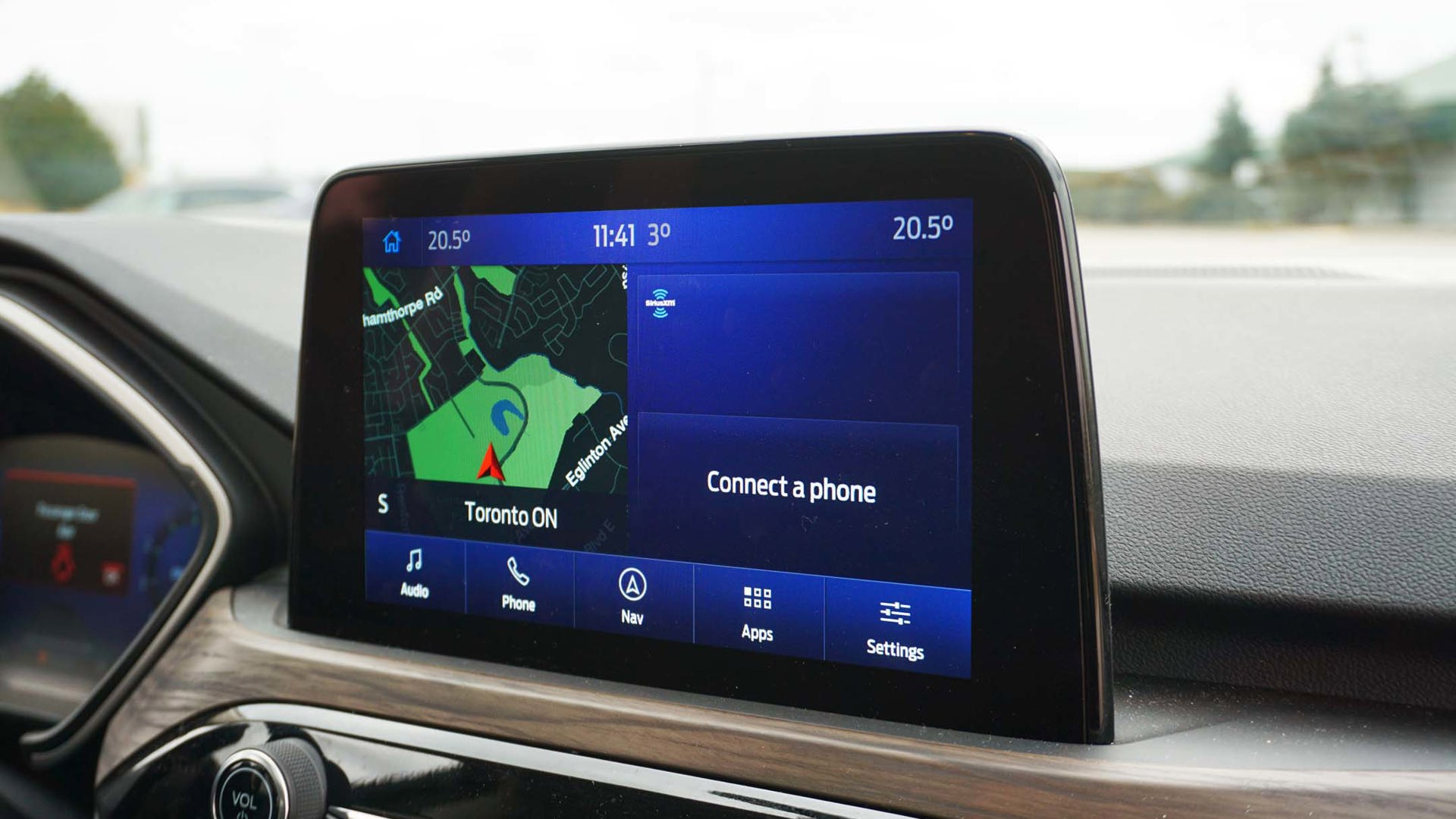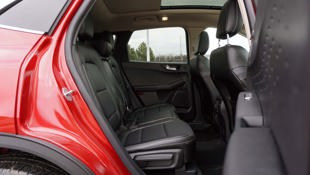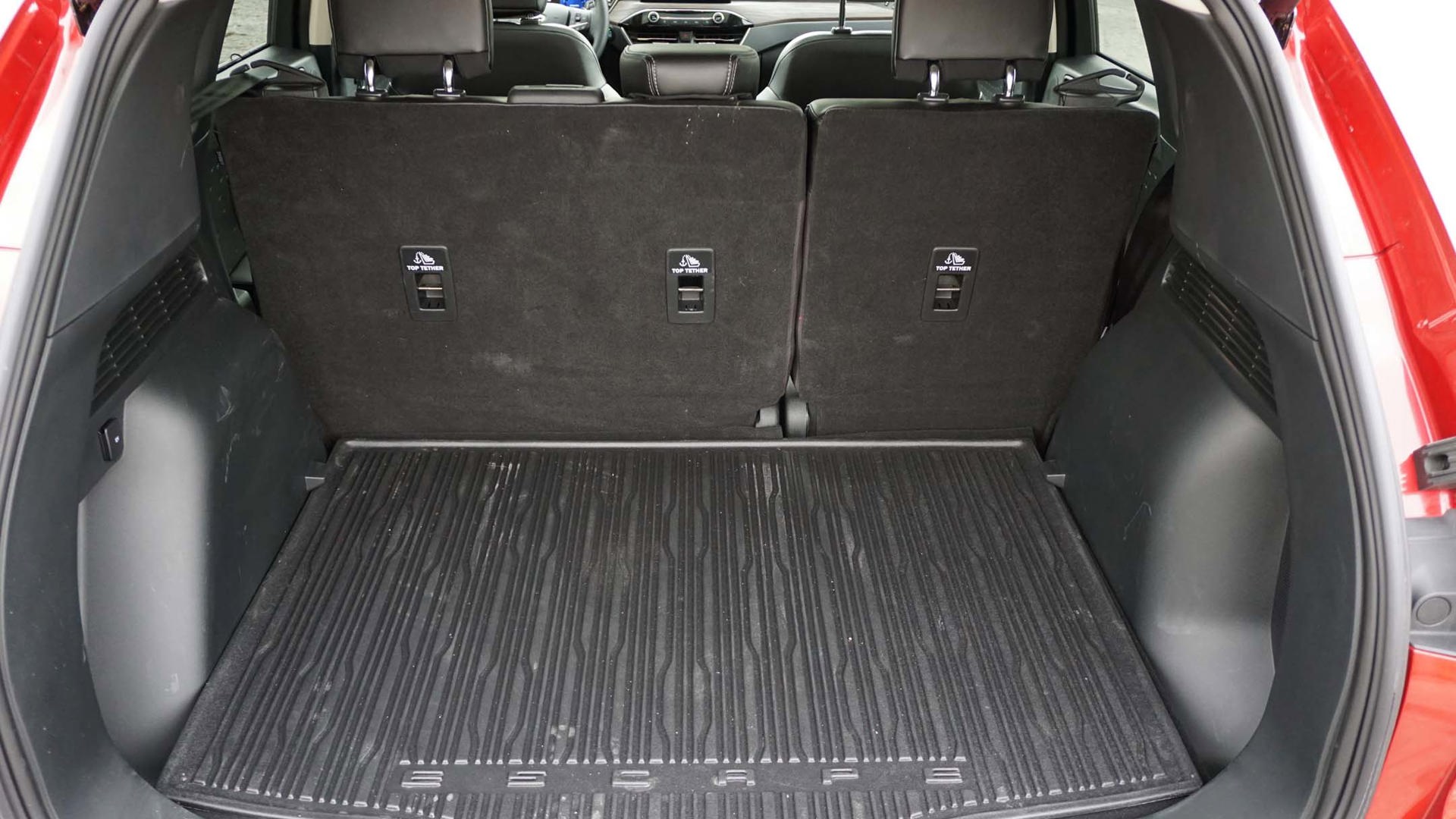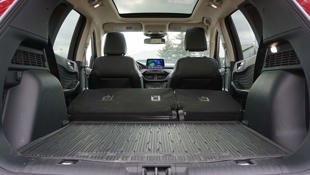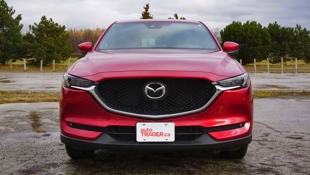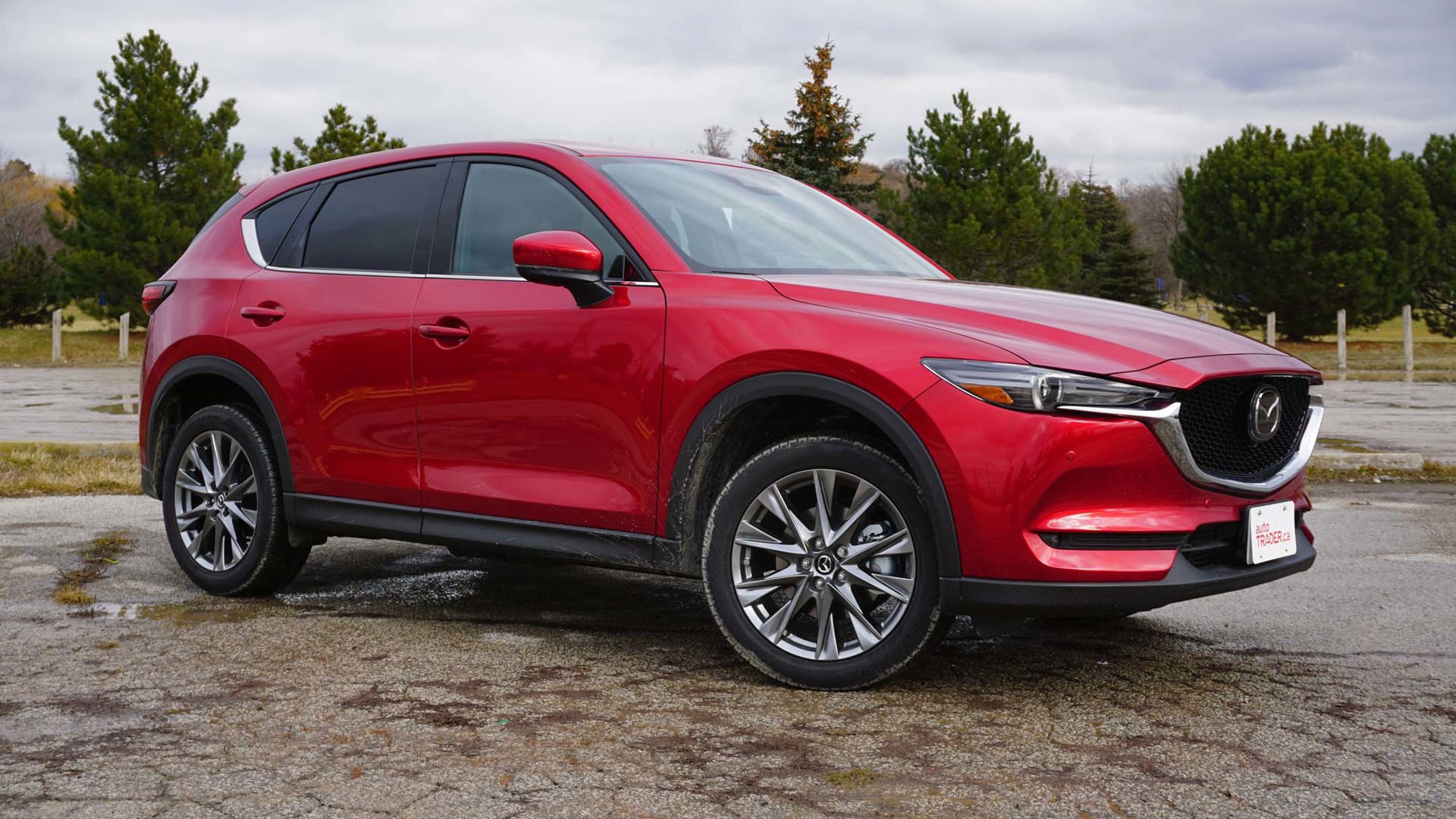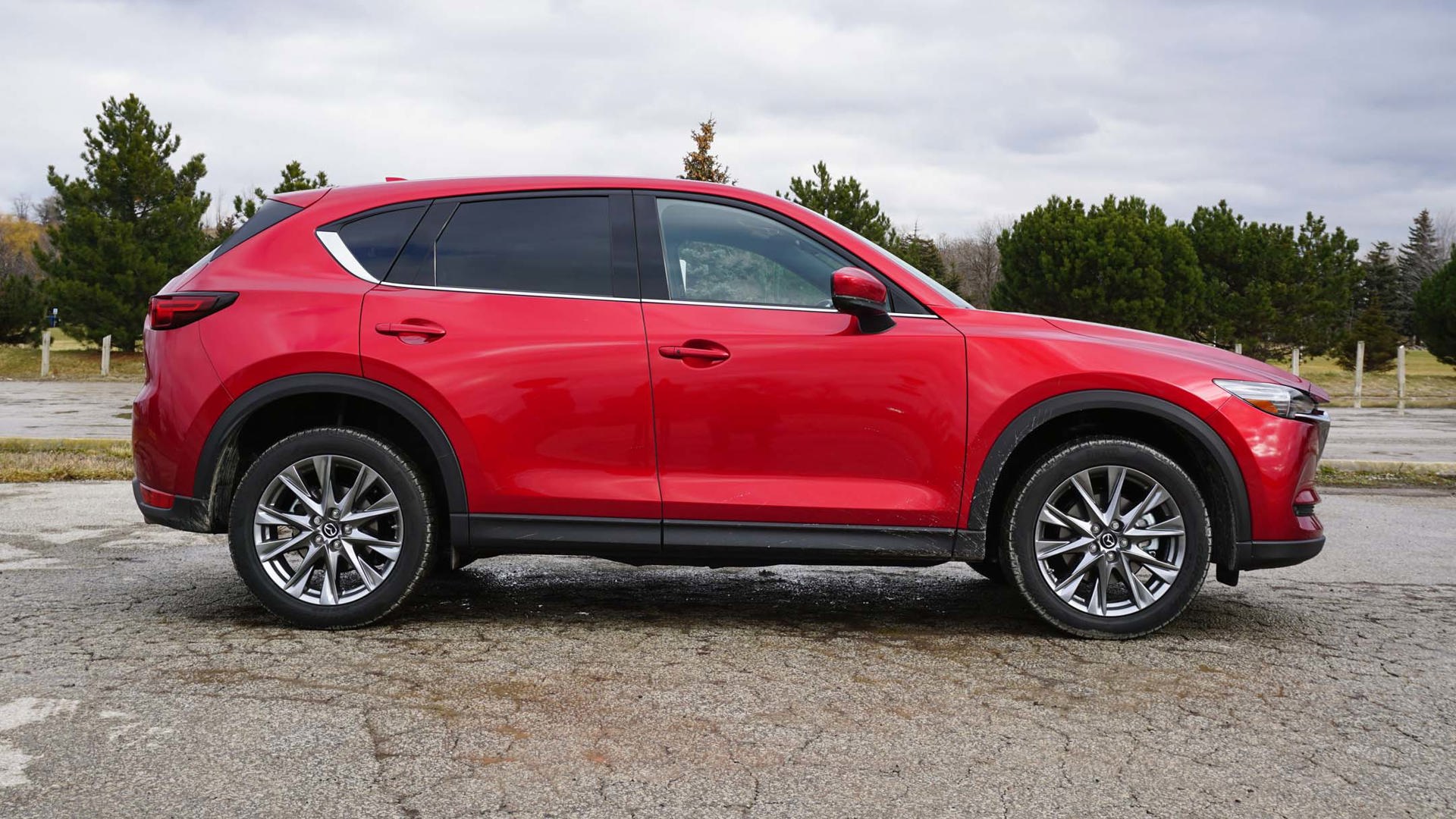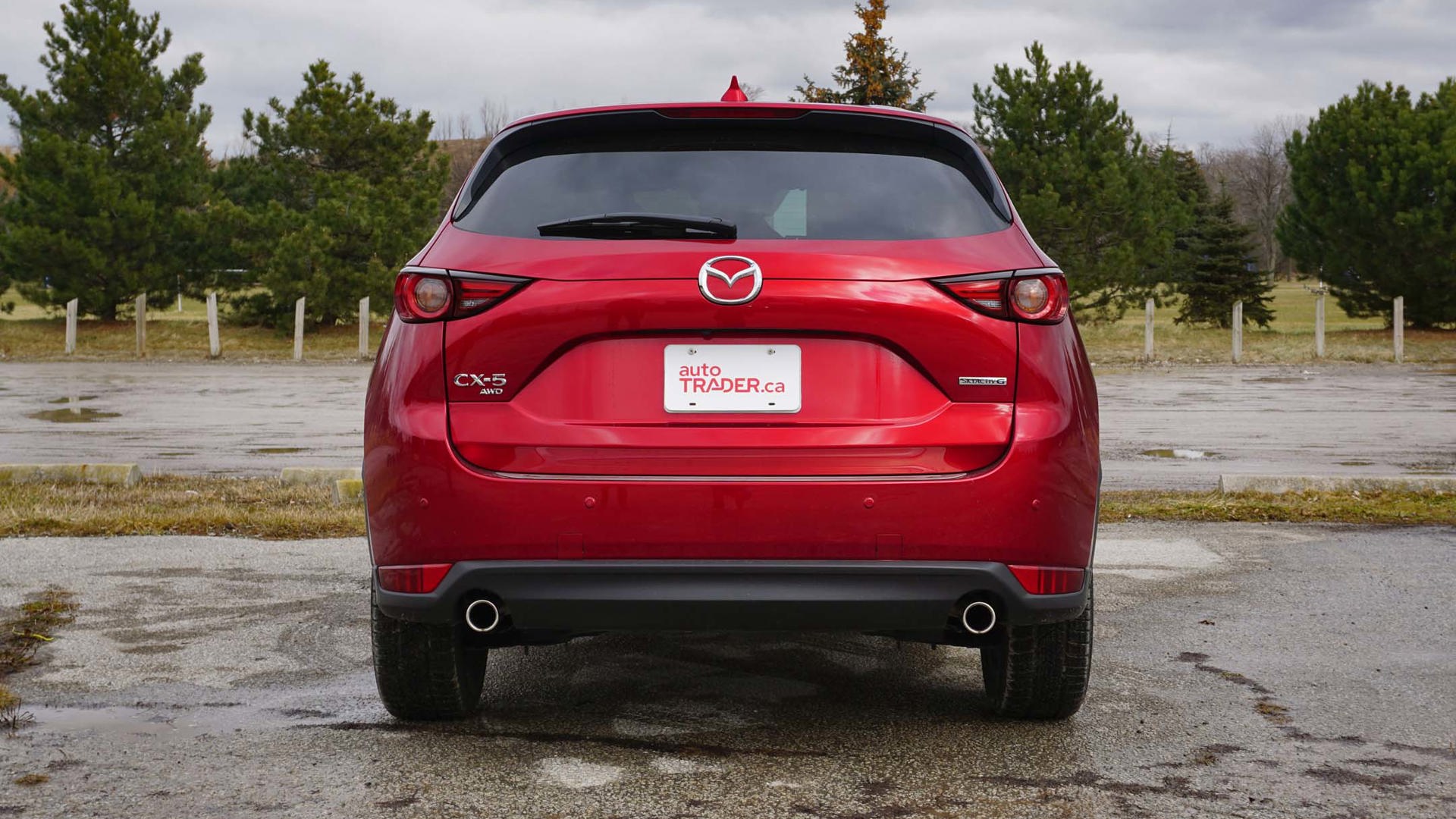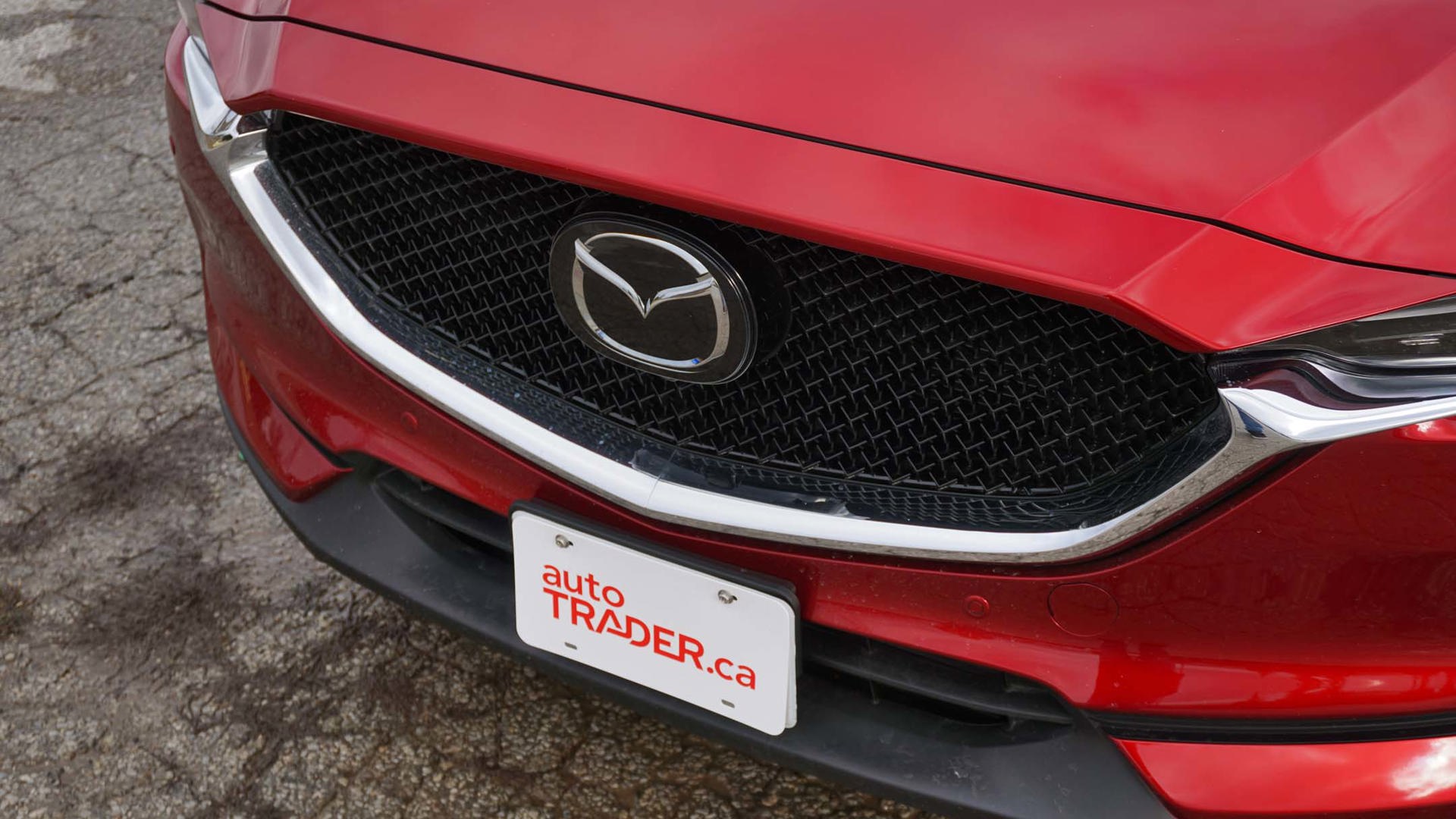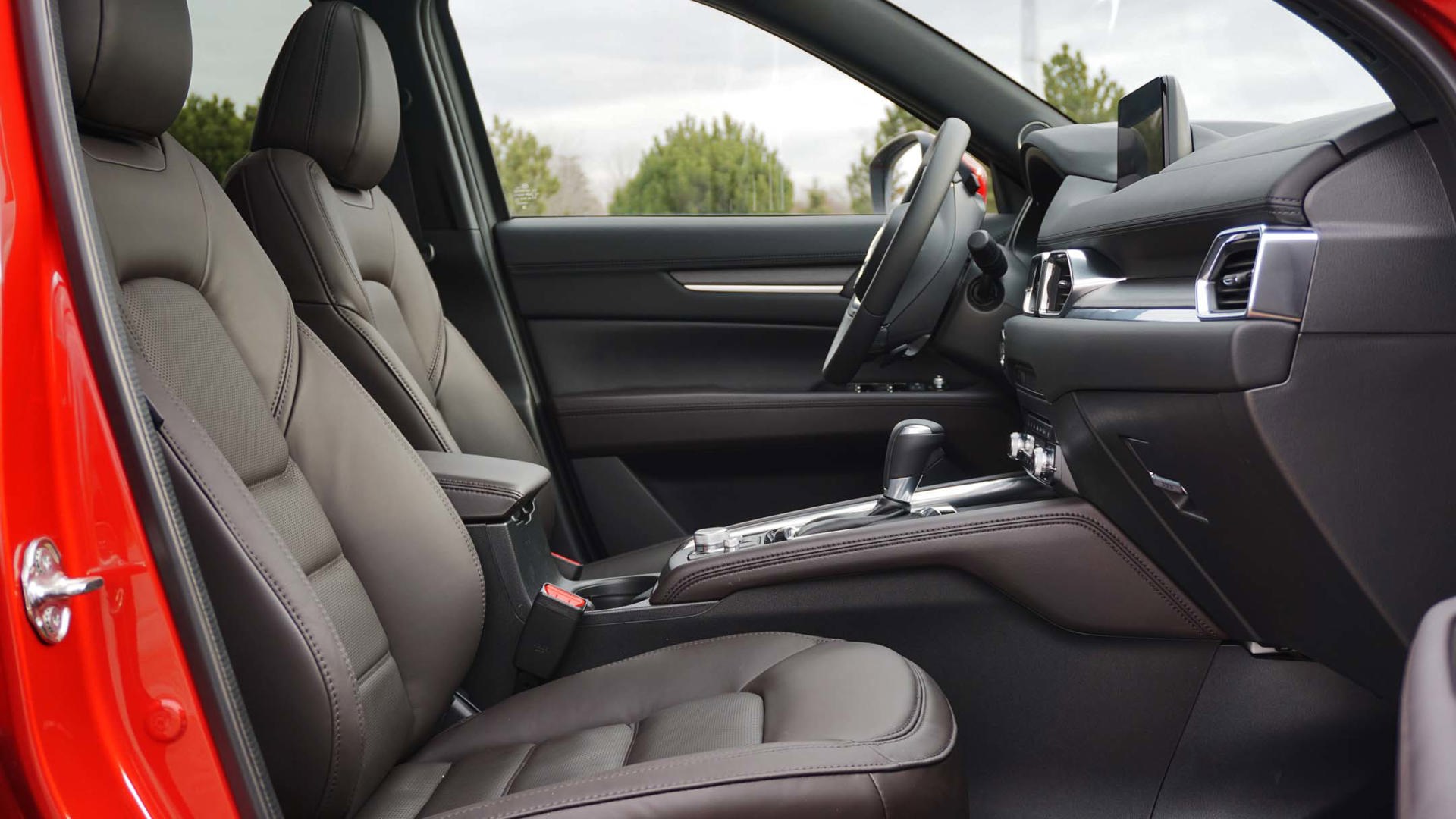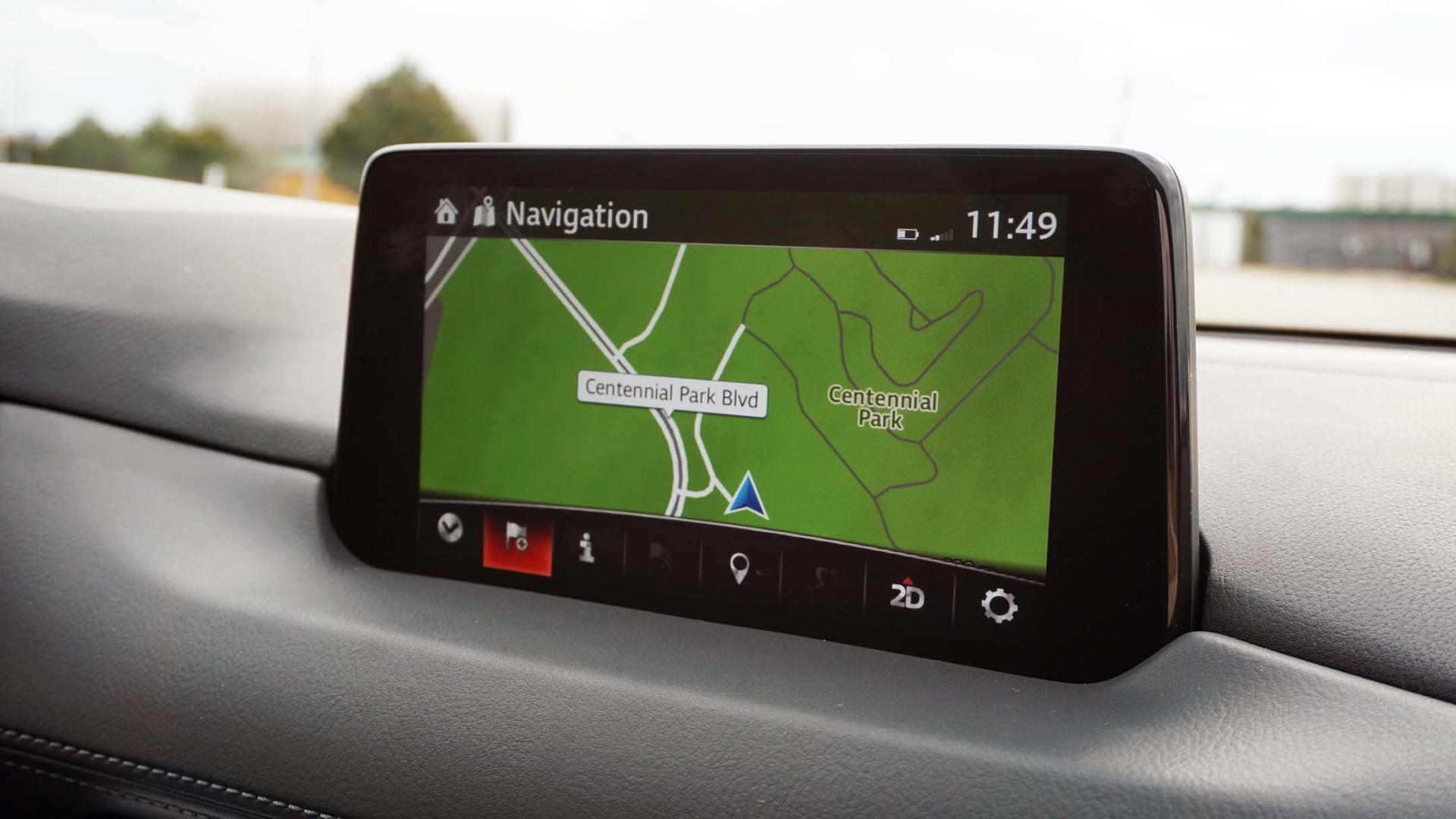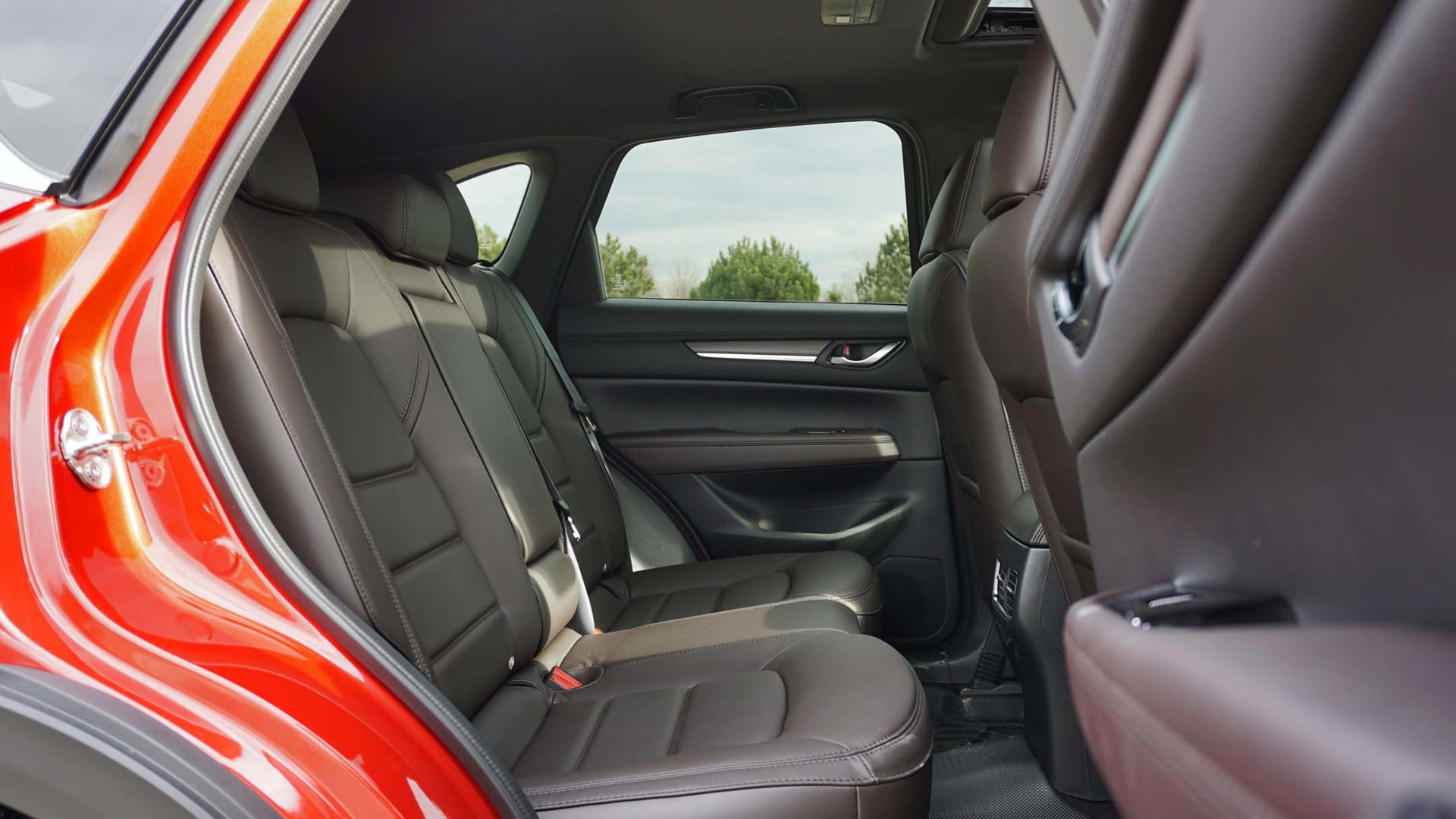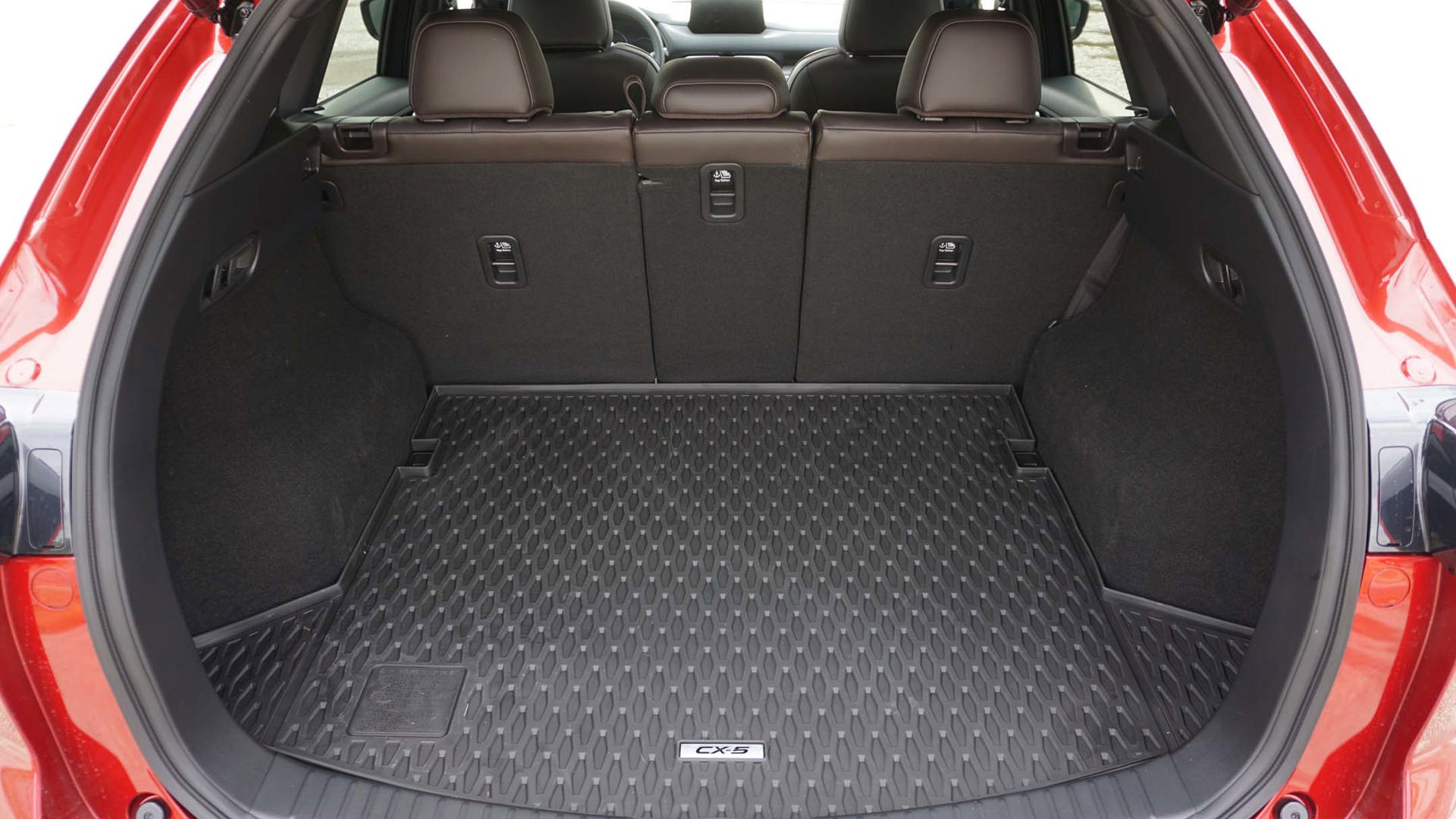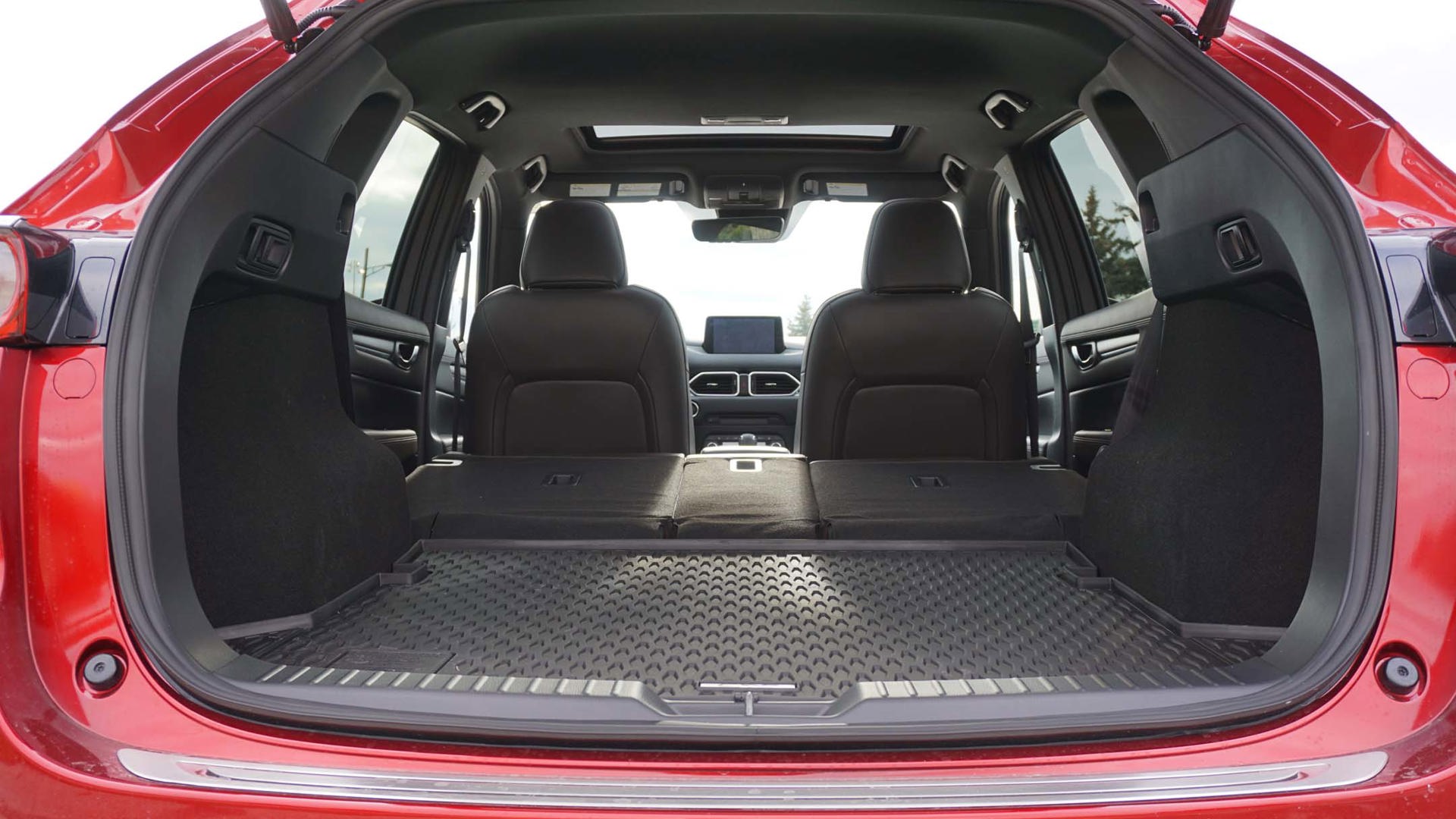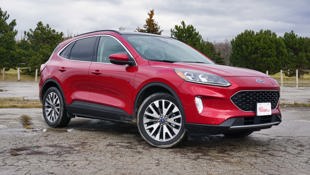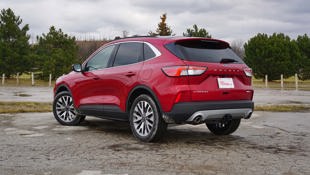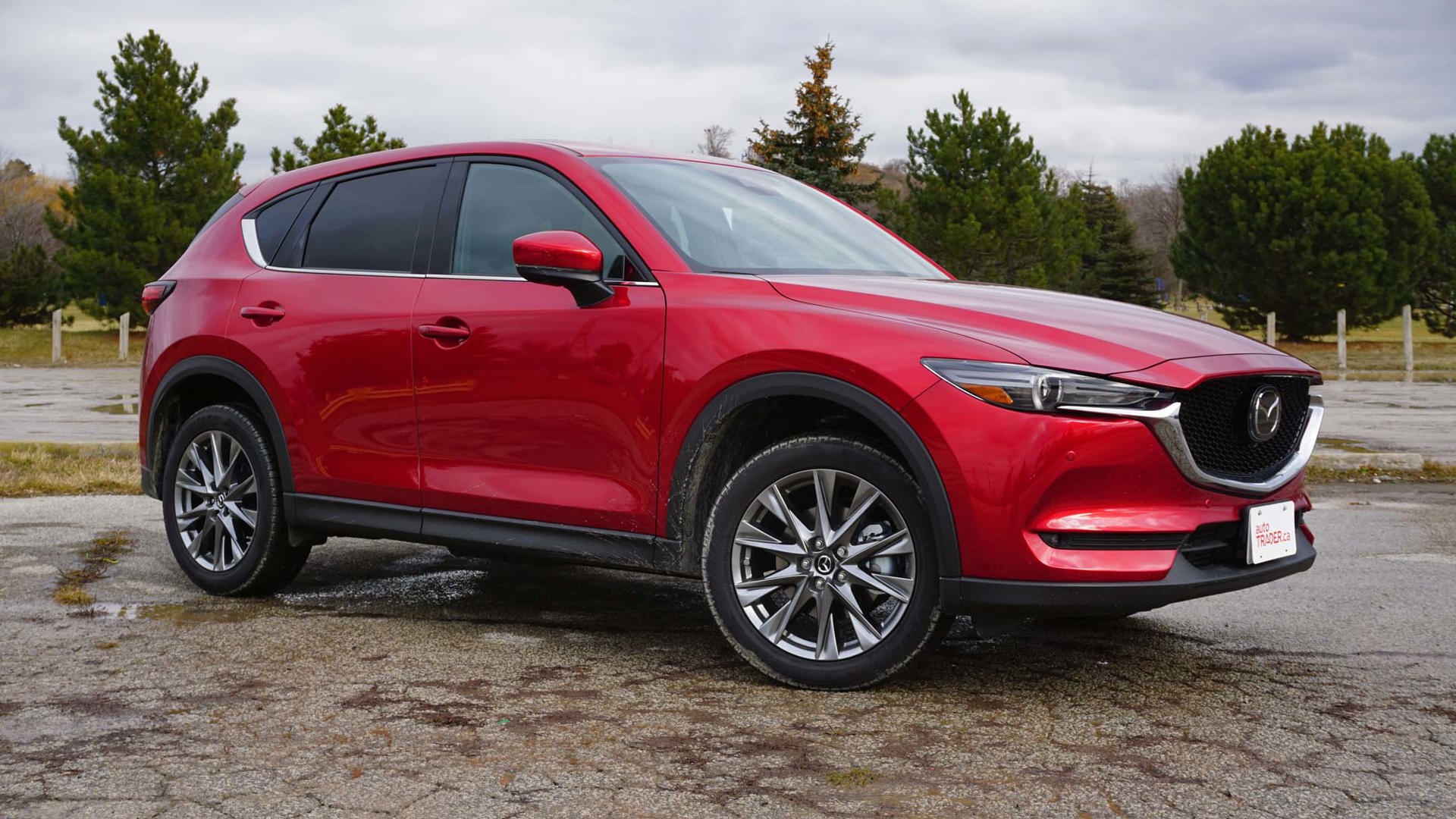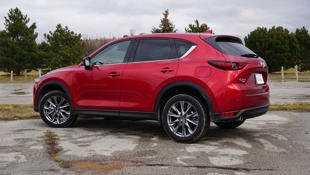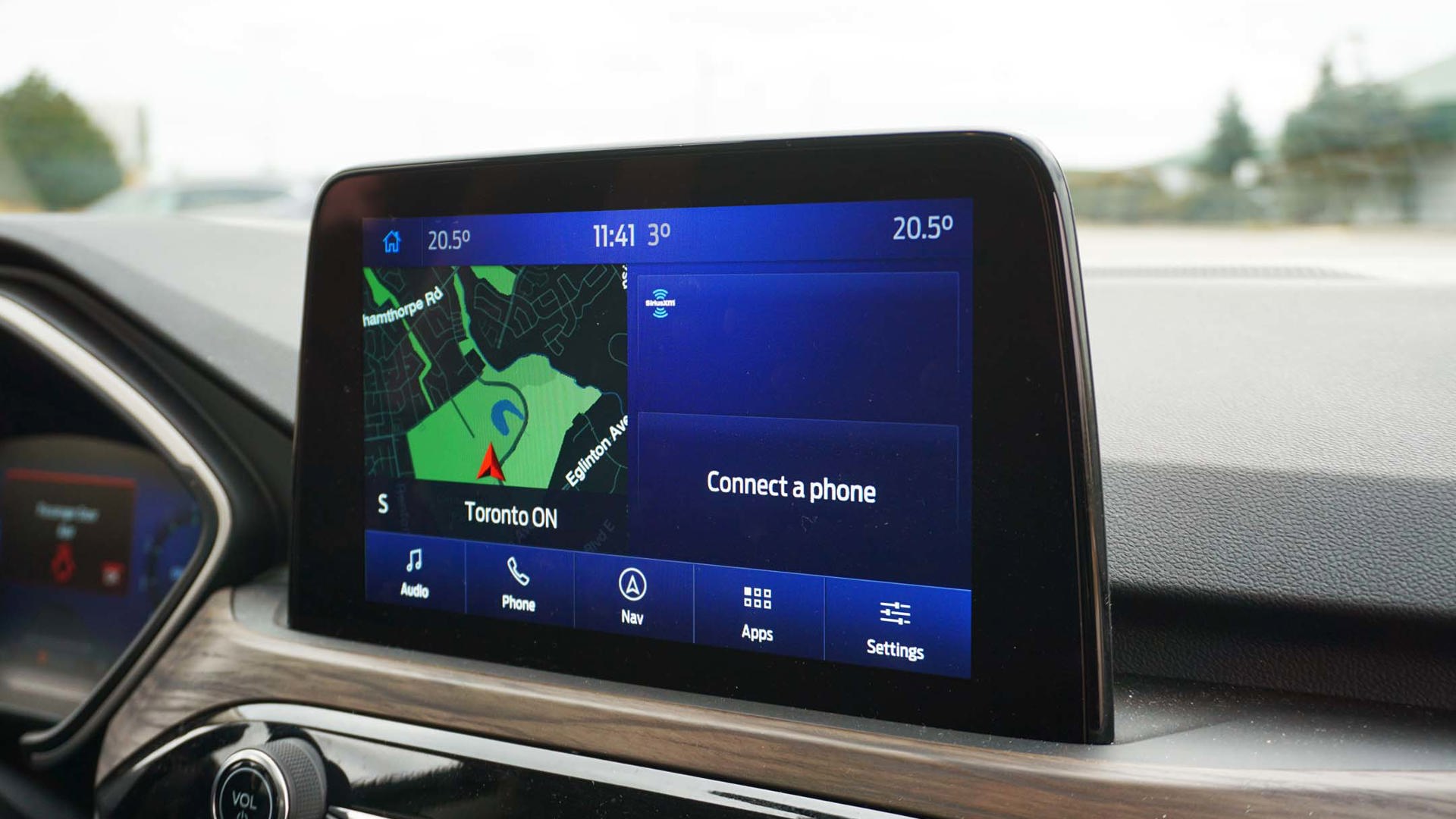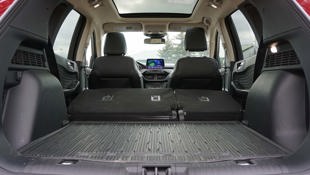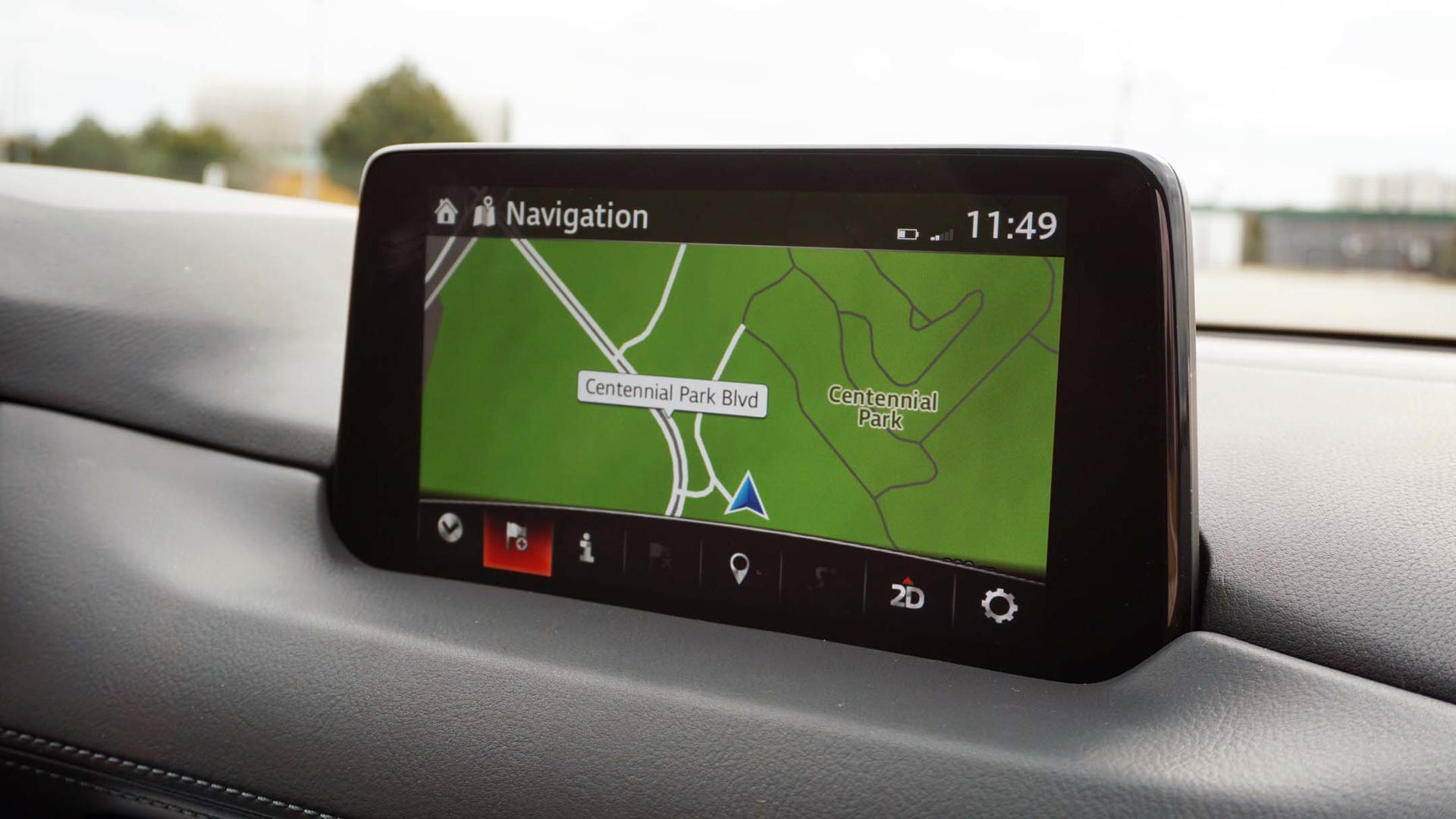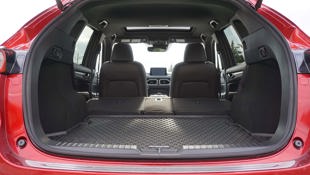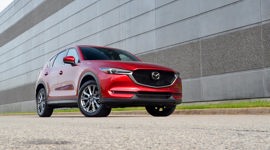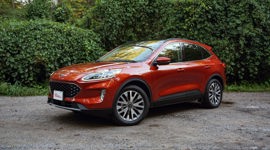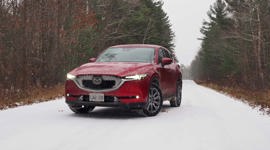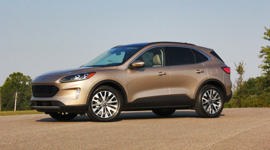Comparison Data
|
2020 Ford Escape Titanium
|
2020 Mazda CX-5 Signature
|
|---|---|
|
Engine Displacement
2.0L
|
2.5L
|
|
Engine Cylinders
Turbo I4
|
Turbo I4
|
|
Peak Horsepower
250 hp
|
250 hp
|
|
Peak Torque
280 lb-ft
|
320 lb-ft
|
|
Fuel Economy
10.4/7.5/9.1 L/100 km cty/hwy/cmb
|
10.8/8.7/9.8 L/100 km cty/hwy/cmb
|
|
Cargo Space
869 / 1,852 L seats down
|
875 / 1,687 L seats down
|
|
Base Price
$40,049
|
$41,900
|
|
A/C Tax
$100
|
$100
|
|
Destination Fee
$1,850
|
$1,950
|
|
Price as Tested
$45,049
|
$43,295
|
|
Optional Equipment
|
It may be news to some but Mazda has been designing some beautiful vehicles with extremely high-end interiors. Beyond that, the Japanese automaker has switched gears on its driver-centric approach, ensuring the person behind the wheel is comfortable and cared for while enjoying the sporty dynamics the brand is known for. A good example of this is the 2020 CX-5 Signature, which takes the Mazda’s compact crossover, adds a turbocharger under the hood, and ups the premium feel of the cabin.
It’s not the only compact with a powerful engine and responsive handling, as the new 2020 Ford Escape demonstrates. Its Titanium models are also loaded with a ton of technology and creature comforts, making it the perfect foil for the Signature-trim Mazda.
Styling
Mazda’s Kodo design language has proven to be a winner, bestowing even mainstream body styles like crossovers with attractive proportions. A large grille is flanked by slim headlights and clean body lines that look even nicer with the extra-cost Soul Red Crystal Metallic paint finish. The design loses its momentum at the rear end of the vehicle, however, where it looks a bit bland.
Mazda makes up for this with an interior that’s a step above other vehicles in this class, the Escape included. Mind you, this mainly applies to the materials and quality of the cabin. Soft leather upholstery is flanked by nice metallic accents, while the controls feature knurled textures with a tactile response that’s usually found in luxury or premium vehicles. The gauge cluster design is clean and elegant. The lowlight is the tiny infotainment screen perched on top of the dashboard.
The Ford Escape doesn’t have the same curb appeal as the Mazda, but it sports a clean modern look. From a distance, it even looks a bit like the recently announced Aston Martin DBX SUV! Sadly, up close the Escape loses its charm. Reminiscent of the last-generation Ford Focus, the Escape smooths that look out and inflates the dimensions a bit.
The Escape’s interior is a bit conventional when compared to the Mazda, but it gets the job done. It’s well laid out and appointed, although I’m not a fan of the dimpled design on the door panels and a few pieces of wood trim look out of place. The controls aren’t as fancy as in the Mazda, but the Escape boasts a larger touchscreen for its infotainment system, one that looks far less awkward on the dashboard.
Mazda CX-5 Styling: 8.5/10
Ford Escape Styling: 7/10
Safety
Both of these crossovers are equipped with a long list of safety features and driver assistance systems. Standard features on the CX-5 include smart city brake support, blind spot monitoring, and rear cross-traffic alert; pedestrian detection, lane-keeping assistance, automatic high-beams, and adaptive cruise control are found on the GS trim. The Signature trim gets a 360-degree-view camera and parking sensors for the front and rear of the vehicle, for extra confidence in tight urban parking spots. The IIHS tested Mazda’s crashworthiness and the reliability of the crash prevention systems, giving the Top Safety Pick Plus rating, the highest a vehicle can receive.
The Escape was also tested by the IIHS but earned a score just below the CX-5, as a Top Safety Pick. The institute had some issues with the Escapes headlights, suggesting they’re not as bright and produce some unwanted glare. The Escape comes with Ford’s Co-Pilot 360 suite of safety equipment, which is comparable to the CX-5’s standard safety equipment with features like automatic high-beams, blind spot information system with cross-traffic alert, lane-keeping assistance, pre-collision assist with automatic emergency braking, and a rear-view camera. The Titanium model in this comparison boasts an automatic parking system, as well as the Co-Pilot360 Assist Plus package, which includes adaptive cruise control, rear parking sensors, and lane-keeping assistance.
Mazda CX-5 Safety: 8.5/10
Ford Escape Safety: 8/10
Practicality
Compared with the competition, the passenger and cargo space of both the CX-5 and Escape are just about average. However, the CX-5 still boasts 875 litres behind the second row of seating, and when you fold the rear seats down, there’s a total of 1,687 litres. It’s also worth pointing out that the rear seats fold with a 40/20/40 split, which can be useful in select situations.
The Escape has more storage space with 974 litres behind the rear seats, and 1,851 litres when the seats are folded. But like the CX-5 it has a neat party trick in the form of sliding rear seats, which help provide more legroom to the rear seat passengers. The Escape has slightly more accommodating rear seat dimensions and will be the better choice for buyers with small families or friends to ferry around.
Mazda CX-5 Practicality: 6.5/10
Ford Escape Practicality: 8/10
User Friendliness
Mazda has recently included Android Auto and Apple CarPlay support on its vehicles, and that goes a long way towards improving the infotainment system. Otherwise, the 7-inch screen looks and feels a bit dated, and requires the use of a rotary knob while on the move. When the car is stopped, the touchscreen is usable, which makes sense as the screen is just out of reach, and would be a bit more frustrating to use while driving.
Beyond the infotainment system, the CX-5 provides a helpful amount of data to the driver at a glance. The white and black gauge cluster is easy to read at night, and there’s a real head-up display, rather than the flimsy plastic piece found on the Escape. Finally, as mentioned before, the tactile controls in the cabin help it feel a bit more user-friendly. You can change HVAC settings without looking thanks to the knobs, and that’s always appreciated.
The Escape also has Android Auto and Apple CarPlay support and uses a touchscreen that shows plenty of information in an easy-to-read manner. The screen is much larger and is responsive as well, but there’s the usual worry of being distracted when using it while driving. I’m not a fan of the head-up display in the Escape, which looks cheap and isn’t all that useful, but I do like the digital gauge cluster, which is bright and full of information. Like the CX-5 the Escape has plenty of physical controls, although the knob detents have less “click” to them than those in the Mazda.
Mazda CX-5 User Friendliness: 7/10
Ford Escape User Friendliness: 8/10
Features
In addition to its head-up display, active parking assistance, and digital gauge cluster; the Escape Titanium is loaded with features like heated front seats, heated steering wheel, rain-sensing wipers, a panoramic sunroof, a universal garage door opener, and a B&O-branded sound system.
The CX-5 has heated seats all around, as well as ventilated seats up front, a heated steering wheel, a Bose-branded sound system with 10 speakers, and a garage door opener that’s placed on a very attractive looking frameless rear-view mirror. It’s worth pointing out that the moonroof in the CX-5 is smaller than the Escapes.
Mazda CX-5 Features: 7/10
Ford Escape Features: 8/10
Power
Under the hood of the Mazda CX-5 signature is a 2.5-litre turbocharged engine that makes 250 horsepower and 320 lb-ft of torque. It’s paired to a six-speed automatic transmission and features all-wheel drive. It’s an extremely potent engine, allowing drivers to get up to speed and make passes with confidence. Among all the engine options in the CX-5 (a base 2.5L engine, and a diesel) the 2.5L Turbo is the best choice, and one of the highlights of the vehicle. One item that could be modernized is the transmission, which can sometimes feel a bit slow when dropping gears for more acceleration, or too hasty when upshifting. A sport toggle by the gearstick helps, but introduces a lot of noise in the process.
The Escape is offered with several engine options, including a base 1.5-litre turbo and two hybrid gas–electric choices, but the model we have has the 2.0-litre turbocharged four-cylinder that makes 250 horsepower and 280 lb-ft of torque. This is paired with an eight-speed automatic and the Escape also features AWD. The Escape feels slightly quicker off the line thanks to the extra gear ratios, but when cruising on the highway you could feel the difference in torque. During our testing, the Escape had a noticeable hiccup when changing gears at low speeds, usually when going from first to second gear, but this will likely be smoothed out with a software tune.
Mazda CX-5 Powertrain: 9/10
Ford Escape Powertrain: 8.5/10
Comfort
The CX-5 and Escape feel very refined but aren’t plush couches while on the road. The CX-5’s seating is a bit firm and maybe too upright, leaving a poor first impression. The tight rear seats don’t help much either. The suspension can feel a bit stiff, but not as much as the Escape. There’s a minimal amount of body roll, and it is controlled nicely.
The Escape is more spacious and feels less claustrophobic than the CX-5, and the seats are slightly better than the Mazda as well, making it seem ideal for long road trips. However, the suspension is a bit rougher than expected for a crossover, leading it to be ideal for buyers who prefer a more car-like ride.
Mazda CX-5 Comfort: 7/10
Ford Escape Comfort: 7.5/10
Driving Feel
The CX-5 is one of the most enjoyable crossovers on the market, thanks to its excellent steering and responsive chassis. To help its case, Mazda has included something known as G-Vectoring Control Plus, a system that limits a tiny bit of engine torque on steering inputs to shift weight towards the front wheels and improve steering feel and responsiveness. Combine that with the excellent motor, and it’s hard to find a fault with the CX-5 in terms of its driving dynamics.
The Escape isn’t far off. The steering feels a bit less engaging than the Mazda, but Ford has managed to make the Escape feel like a smaller more agile vehicle, something that is rare in this class, where compact crossovers can feel like lumbering giants.
Mazda CX-5 Driving Feel: 9/10
Ford Escape Driving Feel: 8/10
Fuel Economy
When equipped with the 2.0-litre turbocharged engine, the Ford Escape has NRCan (Natural Resource Canada) ratings of 10.4 L/100 km in the city, 7.5 on the highway and 9.1 combined. The highway efficiency is surprisingly good, but sadly, the Escape isn’t among the more fuel-efficient vehicles in this class.
Then again, neither is the turbocharged CX-5 which is rated at 10.8 L/100 km in the city, 8.7 on the highway and 9.8 in combined conditions. Both of these engines are the range-topping choices, and better fuel efficiency will be found in the naturally aspirated CX-5 or smaller-engined Escape. Alternatively, the Escape comes as a Hybrid in this trim level, which environmentally conscious shoppers may prefer.
Mazda CX-5 Fuel Economy: 6/10
Ford Escape Fuel Economy: 7/10
Value
The Escape Titanium tested has a few unnecessary options like $150 cargo mats and $150 floor mats, and has an as-tested price of $45,049 which includes destination and delivery fees. The CX-5 has just one option, the $450 Soul Red Crystal Metallic Paint finish, and features a price tag of $43,295 including delivery fees.
Different drivers will have different priorities on features, and therefore a different definition of value. The CX-5 is slightly more comfortable, with its rear heated and front cooled seats, and it also features a spiffy head-up display. The Escape, however, has a high-tech cabin with a nicer infotainment system, an active parking assistant, and is much more spacious and fuel-efficient, leading us to give it the edge in terms of value.
Mazda CX-5 Value: 7/10
Ford Escape Value: 8/10
The Verdict
It’s safe to say that these vehicles go above and beyond the usual offerings in this class, by featuring higher horsepower engines and extra equipment in terms of luxury appointments or high-tech goodies. While the CX-5 feels great on the road, it suffers in terms of fuel economy and spaciousness, which are important qualities in this class. The Escape is a better all-around crossover, and full of creature comforts to make it feel like more than just a jack of all trades.
Mazda CX-5 Total: 75.5
Ford Escape Total: 78
